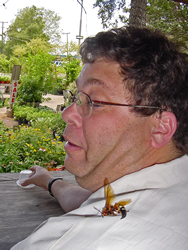Last week I was reminded of the movie "The Green Mile"
which is about a huge-but-gentle man who was falsely convicted
of murdering two children just because he was trying to save their
lives. Claude Townsend, the cactus and succulents expert for PLANTanswers.com
(Send all cactus and succulent questions directly to Claude at:
ctownsend@satx.rr.com ) telephoned that his business site at C&E
Cactus & Things has been invaded by GIANT WASPS!!!!! I told
Claude that these giant wasps are Cicada killers (Sphecius speciosus)
and are related to mud daubers or dirt daubers on the wasp family
tree. They average greater than one inch in length and are recognized
by their amber-colored wings and yellow/orange/black bodies. Cicada
killers' size leads one to believe that they are aggressive and
dangerous. They are frequently seen zooming around just above
the grass or soil and sometimes they are observed crashing into
windows. These patrolling behaviors are exhibited by the male
cicada killer. Males patrol territories for females and will chase
other males away; hence the window-crashing behavior when they
see their reflection. Above all of this, male cicada killers do
not possess a stinger and, therefore, cannot sting.

Cicada Killers are recognized by their amber-colored wings and
yellow-orange-black bodies.
All of this educational information was obtained from a column
written by Nathan Riggs and found at: http://bexar-tx.tamu.edu/HomeHort/F1Column/2004Articles/AUG22.htm
could not convince Claude or his lady customers who were being
dive-bombed by the GIANT WASPS that these creatures are not violent
and are not dangerous. They had to die - and die within 12 hours
- or his cactus sales would suffer. Such was the fate of the gentle
giant on "The Green Mile". I knew these wasps were innocent
and harmless but their size, family reputation and constant patrolling
made them a detriment to cactus sales.

Cicada Killer wasps average greater than one inch in length but
do not sting.
There are two ways to deal with cicada killers. The first is
a non-chemical option that uses weed-blocking landscape fabric
to deter any further digging in the area. Unfortunately, if the
area is already planted, it is difficult to put a weed-blocking
fabric in place. So that means one must use the second option
of applying a insecticidal dust. I told him to find the active
tunnels and apply a small amount (one or two teaspoons) of any
dust insecticide such as Orthene to the tunnel opening, but DO
NOT close the tunnel. This will allow the cicada killer to track
the dust into the tunnel. Sprays or granules will provide some
benefit, but not as well as dust insecticides.
After Claude insisted I take part in the elimination of this
gentle, wasp giant, I convinced him to make amends for this unnecessary
killing by providing us with beautiful images and a description
of one of the most beautiful succulents in the world-the Desert
Rose. He agreed.
The 'Desert Rose' ('Mock Azalea', 'Impala Lily', 'Sabi Star')
originated in Eastern Africa to southern Arabia. It has a short
stubby top with a large hour glass base, sometimes as large as
3 feet thick. This plant is noted for its natural bonsai look.
Flowering of these plants begin when they are 6 inches tall. The
flowers range in color from bright red to purple to white with
many variations as seen in the images on PLANTanswers. These plants
are only cold-hardy to 35 degrees F. so they will be killed in
the winter without protection. Even extended periods of time when
temperatures are below 45 degrees F. can cause damage to tender
roots and small branches. During the winter, the plants should
be kept above 50 degrees F.
As with most blooming plants, the 'Desert Rose' flowers best
in a full sun exposure. Propagation of the plants is from cuttings
or seeds. When watering potted plants, water often, keeping the
soil damp in the major growing season. During the winter, keep
the soil on the dry side but never allow it to get completely
dry. With that said, over-watering will kill the plant because
it will get root rot. To keep the plant moist but not too wet,
use a well-draining cactus potting media.
This plant like the Euphorbia secrets a white, milky and usually
poisonous latex sap which should be avoided when handling.
So there you have the story of The Harmless Wasp and the Thorny
Beauty-the two which could not co-exist.
|



